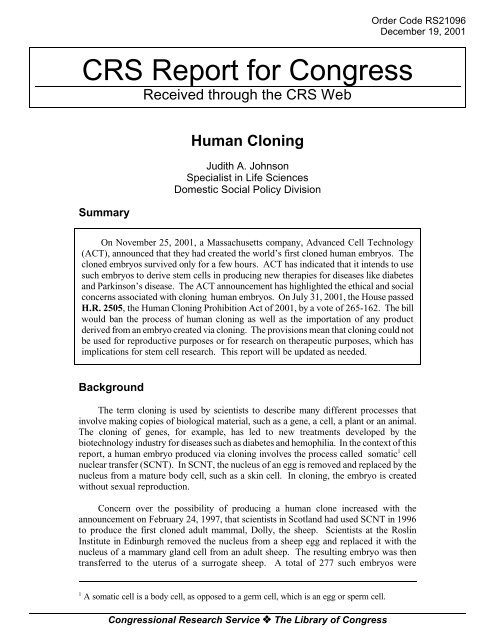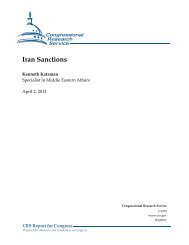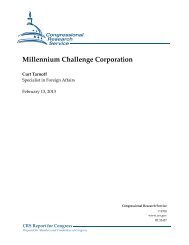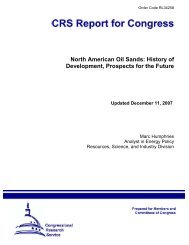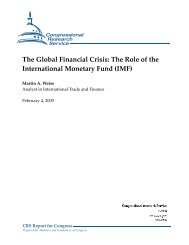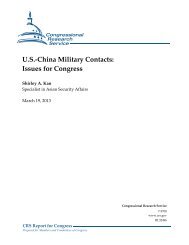Human Cloning - University of Maryland School of Law
Human Cloning - University of Maryland School of Law
Human Cloning - University of Maryland School of Law
Create successful ePaper yourself
Turn your PDF publications into a flip-book with our unique Google optimized e-Paper software.
CRS Report for Congress<br />
Received through the CRS Web<br />
Summary<br />
<strong>Human</strong> <strong>Cloning</strong><br />
Judith A. Johnson<br />
Specialist in Life Sciences<br />
Domestic Social Policy Division<br />
On November 25, 2001, a Massachusetts company, Advanced Cell Technology<br />
(ACT), announced that they had created the world’s first cloned human embryos. The<br />
cloned embryos survived only for a few hours. ACT has indicated that it intends to use<br />
such embryos to derive stem cells in producing new therapies for diseases like diabetes<br />
and Parkinson’s disease. The ACT announcement has highlighted the ethical and social<br />
concerns associated with cloning human embryos. On July 31, 2001, the House passed<br />
H.R. 2505, the <strong>Human</strong> <strong>Cloning</strong> Prohibition Act <strong>of</strong> 2001, by a vote <strong>of</strong> 265-162. The bill<br />
would ban the process <strong>of</strong> human cloning as well as the importation <strong>of</strong> any product<br />
derived from an embryo created via cloning. The provisions mean that cloning could not<br />
be used for reproductive purposes or for research on therapeutic purposes, which has<br />
implications for stem cell research. This report will be updated as needed.<br />
Background<br />
The term cloning is used by scientists to describe many different processes that<br />
involve making copies <strong>of</strong> biological material, such as a gene, a cell, a plant or an animal.<br />
The cloning <strong>of</strong> genes, for example, has led to new treatments developed by the<br />
biotechnology industry for diseases such as diabetes and hemophilia. In the context <strong>of</strong> this<br />
report, a human embryo produced via cloning involves the process called somatic 1 cell<br />
nuclear transfer (SCNT). In SCNT, the nucleus <strong>of</strong> an egg is removed and replaced by the<br />
nucleus from a mature body cell, such as a skin cell. In cloning, the embryo is created<br />
without sexual reproduction.<br />
Concern over the possibility <strong>of</strong> producing a human clone increased with the<br />
announcement on February 24, 1997, that scientists in Scotland had used SCNT in 1996<br />
to produce the first cloned adult mammal, Dolly, the sheep. Scientists at the Roslin<br />
Institute in Edinburgh removed the nucleus from a sheep egg and replaced it with the<br />
nucleus <strong>of</strong> a mammary gland cell from an adult sheep. The resulting embryo was then<br />
transferred to the uterus <strong>of</strong> a surrogate sheep. A total <strong>of</strong> 277 such embryos were<br />
1 A somatic cell is a body cell, as opposed to a germ cell, which is an egg or sperm cell.<br />
Congressional Research Service ˜ The Library <strong>of</strong> Congress<br />
Order Code RS21096<br />
December 19, 2001
CRS-2<br />
transferred, but only one lamb was born. 2 Analyses <strong>of</strong> Dolly’s genetic material confirmed<br />
that she was derived from the adult lamb’s mammary cell. Proponents maintain that<br />
cloning could be used for a number <strong>of</strong> significant agriculture applications, including the<br />
improvement <strong>of</strong> livestock.<br />
On November 25, 2001, Advanced Cell Technology (ACT) announced that it had<br />
created the world’s first human embryos produced via cloning; the results were published<br />
the following day in an electronic journal. 3 ACT used two techniques to produce human<br />
embryos — SCNT and a second process called parthenogenesis. ACT researchers<br />
obtained eggs from seven women, ages 24 to 32, who were paid $3000 to $5000. In the<br />
SCNT approach, scientists removed the nucleus from 19 eggs and replaced it with a<br />
nucleus from another adult cell. For 11 <strong>of</strong> the eggs, the nucleus came from a skin cell, for<br />
the remaining eight eggs, from cells which cling to the egg and are called cumulus cells.<br />
None <strong>of</strong> the eggs that received a skin cell nucleus divided; seven <strong>of</strong> the eggs with the<br />
cumulus cell nucleus began to divide. Two embryos divided into four cells each, and one<br />
embryo divided into six cells before division stopped. In parthenogenesis, an egg cell is<br />
treated with chemicals causing it to divide without being fertilized by a sperm. ACT<br />
exposed 22 human eggs to the chemicals. After 5 days, six eggs had matured into a larger<br />
mass <strong>of</strong> cells before division stopped. None <strong>of</strong> the embryos developed by ACT through<br />
cloning divided sufficiently to produce stem cells.<br />
The stated goal <strong>of</strong> ACT’s work is not to produce cloned human baby (which requires<br />
implantation <strong>of</strong> the cloned embryo into a woman’s uterus), but human embryonic stem<br />
cells. 4 Other research groups have derived stem cells from mice and cattle using SCNT.<br />
ACT intends to derive stem cells from human embryos to develop new therapies for<br />
diseases such as diabetes and Parkinson’s disease. Stem cells transplanted into a patient<br />
would treat disease or injury by replacing damaged tissue. If the cell nucleus used in<br />
SCNT is from the patient, the stem cells would be genetically identical to the patient,<br />
recognized by the patient’s immune system, and avoid any tissue rejection problems that<br />
could occur in other stem cell therapeutic approaches. Because <strong>of</strong> this, many scientists<br />
believe the SCNT technique may provide the best hope <strong>of</strong> eventually treating patients<br />
using stem cells for tissue transplantation. A California biotechnology company, Geron<br />
Corporation, is also working on stem cells created via SCNT. 5<br />
Ethical and Social Issues<br />
The possibility <strong>of</strong> using cloning technology not just for therapeutic purposes but also<br />
for reproducing human beings raises pr<strong>of</strong>ound moral and ethical questions. In response<br />
to the creation <strong>of</strong> Dolly and concerns about the potential application <strong>of</strong> cloning humans,<br />
2 Wilmut, I., et al. Viable Offspring Derived From Fetal and Adult Mammalian Cells. Nature, v.<br />
385, February 27, 1997. p. 810-813.<br />
3 Cibelli, J.B., et al. Somatic Cell Nuclear Transfer in <strong>Human</strong>s: Pronuclear and Early Embryonic<br />
Development. Journal <strong>of</strong> Regenerative Medicine, v. 2, November 26, 2001. p. 25-31.<br />
4 For more information about stem cells, please see CRS Report RL31015, Stem Cell Research,<br />
by Judith A. Johnson.<br />
5 Weiss, R. Embryo Work Raises Spector <strong>of</strong> <strong>Human</strong> Harvesting. Washington Post, June 14,<br />
1999. p. A01.
CRS-3<br />
on February 24, 1997, President Clinton asked the National Bioethics Advisory<br />
Commission 6 (NBAC) to review the ethical and legal issues associated with the use <strong>of</strong><br />
cloning technology; NBAC reported its findings and recommendations on June 9, 1997. 7<br />
NBAC recommended a continuation <strong>of</strong> the moratorium on the use <strong>of</strong> federal funding in<br />
the support <strong>of</strong> any attempt to create a child by SCNT, and an immediate request to all nonfederally<br />
funded investigators to comply voluntarily with the intent <strong>of</strong> the federal<br />
moratorium. NBAC also recommended that federal legislation be enacted, with a 3- to 5year<br />
sunset clause, to prohibit anyone from attempting to create a child through the use<br />
<strong>of</strong> SCNT in a research or clinical setting. The NBAC found it morally unacceptable to<br />
attempt to clone humans for the purpose <strong>of</strong> human reproduction because scientific data<br />
from animal experiments indicate the method is not safe for mother or baby. 8 In addition<br />
to concerns about physical safety, the NBAC report pointed out that SCNT raises issues<br />
about the individuality, autonomy, objectification and kinship <strong>of</strong> the resulting children.<br />
<strong>Cloning</strong>, if used for human reproduction, may affect society’s perception <strong>of</strong> what it<br />
means to be a human being. Uncertainties over a cloned individual’s personal uniqueness<br />
or freedom to create their own identity may haunt him or her. Relatives or friends could<br />
have specific expectations regarding the cloned individual’s talents and abilities. Others<br />
may ill treat or discriminate against a cloned individual. Some worry that cloning would<br />
lead to diminished respect for human life in general, and for cloned individuals in<br />
particular, since the cloned person might simply be replaced with another clone. Others<br />
point out, however, that this altered perception does not occur today with identical twins,<br />
who are naturally produced clones. <strong>Cloning</strong> human embryos also raises difficult questions<br />
about the rights <strong>of</strong> parents to control their own embryos and other issues concerning<br />
reproductive rights and privacy. Some observers believe that it would be ethical to clone<br />
human embryos to help infertile couples conceive.<br />
<strong>Human</strong> Embryo Research: Policy, Regulations, Guidelines<br />
Currently no U.S. laws or regulations would prohibit all cloning research. However,<br />
federal funding <strong>of</strong> any type <strong>of</strong> research involving human embryos, starting with in vitro<br />
fertilization (IVF) then later cloning and stem cells, has been blocked by various policy<br />
6 NBAC was established by Presidential Executive Order 12975 on October 3, 1995, to provide<br />
guidance to federal agencies on the ethical conduct <strong>of</strong> current and future human biological and<br />
behavioral research. A September 16, 1999 executive order extended the NBAC charter until<br />
October 2001. NBAC has been replaced by the President’s Council on Bioethics, which was<br />
described by the Bush Administration in its August 9, 2001 policy decision on human embryonic<br />
stem cell research.<br />
7 National Bioethics Advisory Commission. <strong>Cloning</strong> <strong>Human</strong> Beings. June 1997.<br />
8 On January 7, 1998, a Chicago scientist, Dr. Richard Seed, announced his intention to clone a<br />
human being. In response, bills were introduced in Congress that would have banned human<br />
cloning indefinitely or imposed a moratorium. The legislation was opposed by a number <strong>of</strong> medical<br />
organizations, the biotechnology industry and distinguished scientists and was not enacted. Others<br />
expressing an interest in reproductive cloning include: (1) Clonaid, a company directed by chemist<br />
Brigitte Boisselier and formed by the Raelians, a group that believes humans are descendants <strong>of</strong><br />
extraterrestrials and that cloning can allow humans to become immortal; and, (2) Panos Zavos, <strong>of</strong><br />
the <strong>University</strong> <strong>of</strong> Kentucky, and Severino Antinori, director <strong>of</strong> a fertility clinic in Rome, who are<br />
working together to help infertile couples have children via cloning.
CRS-4<br />
decisions dating back 25 years. Following the birth <strong>of</strong> the first IVF baby, Louise Brown,<br />
in July 1978, the Ethics Advisory Board (EAB) was tasked with considering the scientific,<br />
ethical, legal, and social issues surrounding human IVF. 9 The EAB released its report on<br />
May 4, 1979, which found that IVF research was acceptable from an ethical standpoint<br />
and could be supported with federal funds. The EAB’s recommendations were never<br />
adopted by HHS, the EAB was dissolved in 1980, and no other EAB was ever chartered.<br />
Because federal regulations that govern human subject research stipulated that, at the time,<br />
federally supported research involving human IVF must be reviewed by an EAB, a socalled<br />
“de facto moratorium” on human IVF research resulted. Other types <strong>of</strong> embryo<br />
research ensuing from the development and use <strong>of</strong> IVF, such as cloning and stem cells,<br />
were therefore also blocked. The de facto moratorium was lifted with the enactment <strong>of</strong><br />
the NIH Revitalization Act <strong>of</strong> 1993 (P.L. 103-43, Section121(c)) which nullified the<br />
regulatory provision (45 CFR 46.204(d)) requiring EAB review <strong>of</strong> IVF proposals.<br />
In response, the National Institutes <strong>of</strong> Health (NIH) established the <strong>Human</strong> Embryo<br />
Research Panel to assess the moral and ethical issues raised by this research and develop<br />
recommendations for NIH review and conduct <strong>of</strong> human embryo research. The NIH Panel<br />
released a report providing guidelines and recommendations on human embryo research<br />
in September 1994. It recommended that some areas <strong>of</strong> human embryo research be<br />
considered for federal funding, including SCNT, stem cells and (under certain limited<br />
conditions) embryos created solely for the purpose <strong>of</strong> research. 10 The NIH Panel also<br />
identified areas <strong>of</strong> human embryo research it considered to be unacceptable, or to warrant<br />
additional review. It determined that certain types <strong>of</strong> cloning 11 without transfer to the<br />
uterus warranted additional review before the Panel could recommend whether the<br />
research should be federally funded. However, the Panel concluded that federal funding<br />
for such cloning techniques followed by transfer to the uterus should be unacceptable into<br />
the foreseeable future. The Panel’s report was unanimously accepted by the NIH<br />
Advisory Committee to the Director (ACD) on December 2, 1994.<br />
After the ACD meeting on December 2, 1994, President Clinton directed NIH not<br />
to allocate resources to “support the creation <strong>of</strong> human embryos for research purposes.”<br />
The President’s directive did not apply to research involving so-called “spare” embryos,<br />
those that sometimes remain from clinical IVF procedures performed to assist infertile<br />
couples become parents. Nor did it apply to human parthenotes, eggs that begin<br />
development through artificial activation, not through fertilization. Following the Clinton<br />
December 2, 1994 directive to NIH, the agency proceeded with plans to develop<br />
guidelines to support research using spare embryos. However, these plans were halted on<br />
9 The EAB was created in 1978 by the Department <strong>of</strong> Health Education and Welfare (HEW), the<br />
forerunner <strong>of</strong> the Department <strong>of</strong> Health and <strong>Human</strong> Services (HHS). The EAB was formed at the<br />
recommendation <strong>of</strong> the National Commission for the Protection <strong>of</strong> <strong>Human</strong> Subjects <strong>of</strong> Biomedical<br />
and Behavioral Research. The National Commission operated from 1974 to 1978 and issued 10<br />
reports, many <strong>of</strong> which formed the basis <strong>of</strong> federal regulations for research involving human<br />
subjects (45 CFR 46).<br />
10 National Institutes <strong>of</strong> Health. Report <strong>of</strong> the <strong>Human</strong> Embryo Research Panel, September 27,<br />
1994.<br />
11 These were blastomere separation, where a two- to eight-cell embryo is treated causing the cells<br />
(blastomeres) to separate; and, blastocyst division, in which an embryo at the more advanced<br />
blastocyst stage is split into two.
CRS-5<br />
January 26, 1996, with the enactment <strong>of</strong> P.L. 104-99 which contained a rider that affected<br />
FY1996 funding for NIH. The rider prohibited HHS from using appropriated funds for<br />
the creation <strong>of</strong> human embryos for research purposes or for research in which human<br />
embryos are destroyed. This same rider has been attached to the Labor, HHS and<br />
Education Appropriations Acts for FY1997 through FY2001. 12 Current language, Section<br />
510 <strong>of</strong> the FY2001 Labor, HHS and Education Appropriations Act, included in the<br />
Consolidated Appropriations Act, 2001 (P.L. 106-554), prohibits HHS from using<br />
FY2001 appropriated funds for:<br />
(1) the creation <strong>of</strong> a human embryo or embryos for research purposes; or,<br />
(2) research in which a human embryo or embryos are destroyed, discarded, or<br />
knowingly subjected to risk <strong>of</strong> injury or death greater than that allowed for research on<br />
fetuses in utero under 45 CFR 46.208(a)(2) and Section 498(b) <strong>of</strong> the Public Health<br />
Service Act (42 U.S.C. 289g(b)). For purposes <strong>of</strong> this section, the term “human<br />
embryo or embryos” includes any organism, not protected as a human subject under 45<br />
CFR 46 ... that is derived by fertilization, parthenogenesis, cloning, or any other means<br />
from one or more human gametes [sperm or egg] or human diploid cells.<br />
One month after the Dolly announcement, on March 4, 1997, President Clinton sent<br />
a memorandum to the heads <strong>of</strong> all executive departments and agencies making it<br />
“absolutely clear that no federal funds will be used for human cloning.” This action<br />
extended the congressional ban beyond HHS to all federally supported research. Clinton<br />
also urged the private sector to adopt a voluntary ban on the cloning <strong>of</strong> human beings.<br />
The NIH Guidelines on Stem Cell Research, published by the Clinton Administration in<br />
August 2000, would not have funded research in which: human stem cells are used for<br />
reproductive cloning <strong>of</strong> a human; human stem cells are derived using SCNT; or, human<br />
stem cells that were derived using SCNT are utilized in a research project. The August<br />
9, 2001 Bush Administration policy decision on stem cell research stated that federal funds<br />
will not be used for the cloning <strong>of</strong> human embryos for any purpose.<br />
The Food and Drug Administration (FDA) has sent letters to the research community<br />
stating that the creation <strong>of</strong> a human being using cloning is subject to FDA regulation under<br />
the Public Health Service Act and the Food, Drug and Cosmetic Act. 13 FDA claims that<br />
such research could only occur when an investigational new drug application (IND) is in<br />
effect. Some legal scholars believe that there is no legal basis for the regulation <strong>of</strong> cloning<br />
by FDA. 14 They find little evidence to support FDA’s position that cloned human embryos<br />
are “drugs.” However, the biotechnology industry and the American Society for<br />
12 The original rider, introduced by Representative Jay Dickey, is in Section 128 <strong>of</strong> P.L. 104-99;<br />
it affected NIH funding for FY1996 contained in P.L. 104-91. For subsequent fiscal years, the<br />
rider is found in Title V, General Provisions, <strong>of</strong> the Labor, HHS and Education Appropriations<br />
Acts in the following public laws: FY1997, P.L. 104-208; FY1998, P.L. 105-78; FY1999, P.L.<br />
105-277; FY2000, P.L. 106-113; and FY2001, P.L. 106-554.<br />
13 The FDA position and letter are available at [http://www.fda.gov/cber/genetherapy/clone.htm].<br />
14 Weiss, R. Legal Barriers to <strong>Human</strong> <strong>Cloning</strong> May Not Hold Up. Washington Post, May 23,<br />
2001. p. A1.
15 Ibid.<br />
CRS-6<br />
Reproductive Medicine believe FDA has the authority to regulate cloning and legislation<br />
is unnecessary because FDA regulation is preferred to any new action by Congress. 15<br />
Legislation<br />
On July 19, 2001, the House Judiciary Subcommittee on Crime approved H.R. 2505<br />
(Weldon) by voice vote. The bill would ban the process <strong>of</strong> human cloning as well as the<br />
importation <strong>of</strong> any product derived from an embryo created via cloning. The provisions<br />
mean that cloning could not be used for reproductive purposes or for research on<br />
therapeutic purposes, which has implications for stem cell research. The bill includes a<br />
criminal penalty <strong>of</strong> imprisonment <strong>of</strong> not more than 10 years and a civil penalty <strong>of</strong> not less<br />
than $1 million. A companion bill, S. 790 (Brownback), was introduced in the Senate.<br />
H.R. 2608 (Greenwood), introduced on July 24, 2001, would ban only human<br />
reproductive cloning; the ban would sunset after 10 years. It has the same criminal and<br />
civil penalties as H.R. 2505 when cloning is used “with the intent to initiate a pregnancy.”<br />
On July 24, 2001, the House Judiciary Committee approved H.R. 2505 by a vote <strong>of</strong> 18<br />
to 11 and defeated a substitute that was identical to the Greenwood bill by a vote <strong>of</strong> 11<br />
to19. The Bush Administration announced its support for H.R. 2505 on July 24, 2001.<br />
On July 31, 2001, the House passed H.R. 2505 by a vote <strong>of</strong> 265-162. Prior to the<br />
vote on H.R. 2505, the House defeated a substitute amendment, H. Amdt. 285, which is<br />
identical to H.R. 2608, by a vote <strong>of</strong> 178 to 249. During debate, supporters <strong>of</strong> H.R. 2505<br />
argued that a partial ban on human cloning, such as H.R. 2608, would be impossible to<br />
enforce. Critics <strong>of</strong> H.R. 2505 argued that SCNT creates a “clump <strong>of</strong> cells” rather than an<br />
embryo, and that the measure would curtail medical research and prevent Americans from<br />
receiving life-saving treatments created overseas. On December 3, 2001, the Senate<br />
considered an amendment that would have imposed a 6-month moratorium on all human<br />
cloning research; an attempt to attach the amendment to a separate bill failed.<br />
Some legal scholars believe a ban on human cloning may be unconstitutional because<br />
it would infringe upon the right to make reproductive decisions which is “protected under<br />
the constitutional right to privacy and the constitutional right to liberty.” 16 Other scholars<br />
do not believe that noncoital, asexual reproduction, such as cloning, would be considered<br />
a fundamental right by the Supreme Court. However, in decisions involving IVF, which<br />
is noncoital but not asexual because both parents are required, the justices have suggested<br />
that reproduction by IVF is a fundamental right, but the issue is unresolved. 17 A ban on<br />
human cloning research raises other constitutional issues: scientists’ right to personal<br />
liberty and free speech. In the opinion <strong>of</strong> some legal scholars, any government limits on<br />
the use <strong>of</strong> cloning in scientific inquiry or human reproduction would have to be “narrowly<br />
tailored to further a compelling state interest.” 18<br />
16 Andrews, L. B. Is There a Right to Clone? Constitutional Challenges to Bans on <strong>Human</strong><br />
<strong>Cloning</strong>. Harvard Journal <strong>of</strong> <strong>Law</strong> and Technology, summer 1998. p. 643-680.<br />
17 Weiss, Legal Barriers to <strong>Human</strong> <strong>Cloning</strong> May Not Hold Up, p. A1.<br />
18 Andrews, Is There a Right to Clone?, p. 667.


